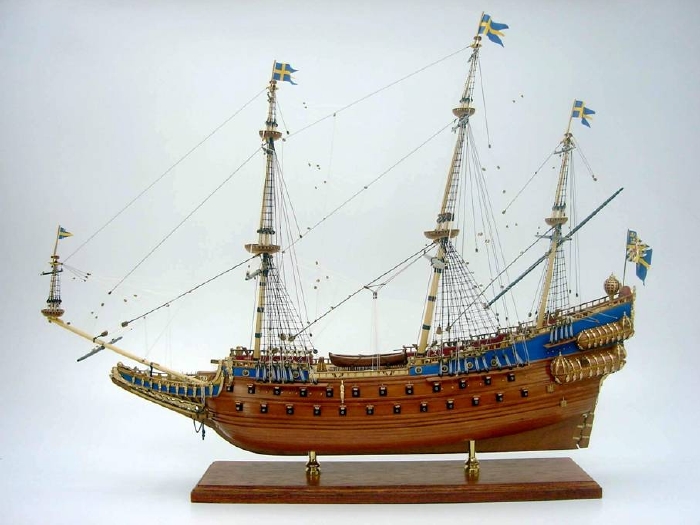Hi all 8) ,
Since skeleton bob and those others are working on new ship models, I maybe have a suggestion to make this beauty take a look at this
some information:
The WASA had 10 sails, six have been preserved, 64 cannons (3 preserved).
The ship could hold approx. 450 men, 300 of which were soldiers.
On the day she sank `100-150` men were on board. Twenty skeletons were found and preserved.
Visitors are not allowed on board because the ship is kept in a perpetual low light intensity and moist atmosphere
Around 1650 - a few decades after the Vasa - this changed. At that time the `ship-of`-`the-line`-tactics made its breakthrough. The enemy fleets formed long lines and shot at each other. Close combat was no longer the most important thing.
The warship Vasa is clearly from the transition between intense close combat and the `ship-of`-`the-line`-tactics. She is armed with an extremely powerful artillery - and at the same time well fitted out for close combat. The high stern makes a good platform for firing down at the enemy. The 300 soldiers could have been used for capturing enemy warships.
The Vasa had heavy `24-pound` guns on both her lower and upper gundeck. The standardized artillery was an experiment with supposedly great advantages. By limiting the number of sizes of `cannon-balls` and gun `powder-charges` the warship became more effective. Unfortunately the heavy guns on the upper gundeck was one of the reasons why the Vasa capsized.
Vasa in figures
Length
Total length including bow-
sprit - 69 metres
Length of the hull - 61 metres
Length of the hull between prow
and stern - 47.5 metres
Width
Maximum width - 11.7 metres
Height
From keel to the top of the main
mast - 52.5 metres
Height of the stern - 19.3 metres
Depth
4.8 metres
Displacement
1,210 tons
Sail area
1,275 square metres
No. of sails
10 - of which six have been preserved (the oldest sails in the world)
Armament
64 guns, including:
`24-pounders` - 48
`3-pounders` - 8
`1-pounders` - 2
Mortars - 6
Crew
445 men, including:
Seamen - 145
Soldiers - 300 (not on board when the Vasa sank)
The story:
Ship's history : - When she set sail on her maiden voyage, the ship of the line Wasa was the most impressive ship in the Swedish Navy. She sank within minutes, not a mile from land, and it would be 333 years before she was salvaged. Named for the royal house of Wasa, she was built for the Navy of Gustavus Adolphus, then the dominant military force in the Baltic when Sweden was at war with Poland. Wasa was scheduled to join the existing fleet and on April 10, 1628, she sailed from Stockholm with about 250 people aboard. Orders of the day read “If anyone wishes to have his wife with him, he is free to do so here in the Stockholm Channel, but not on a voyage where the objective is the enemyâ€. The crew had to warp the ship out of the harbour (by pulling the ship up by using the anchor); Wasa had gone no more than fifteen yards when a sudden gust laid the ship on her `beam-ends`. Water rushed in through the open gun ports and she sank immediately . The death toll was estimated at about 50 people, which included wives and children :cry . Many parties were initially blamed including the Captain and the shipbuilder, but there was no conclusive evidence. Thereafter, construction of Swedish warships came under more direct control of the Navy. There were various attempts to salvage her, some of which were partially successful in retrieving artefacts and guns. In 1956 however, amateur archaeologist Anders Franzen succeeded in extracting a core sample of her hull, and efforts soon began to raise the ship. On August 20, 1959, Wasa was pulled from the mud, and transferred to an area where the water was only 15 metres deep. On April 24th 1960 she broke the surface, and two weeks later she floated to dry dock on her own hull. By the autumn, she was safely housed in the museum building where she remained under continuous water spray to prevent her timbers from disintegrating. Wasa’s more than a thousand sculptures and fragments constitute one of the largest collections of `mannerist-style` `seventeenth-century` wooden sculpture in the world. One of the most popular attractions in Sweden since her recovery, Wasa is the centrepiece of the Statens Sjohistoriska Museum on the Stockholm waterfront.
. The death toll was estimated at about 50 people, which included wives and children :cry . Many parties were initially blamed including the Captain and the shipbuilder, but there was no conclusive evidence. Thereafter, construction of Swedish warships came under more direct control of the Navy. There were various attempts to salvage her, some of which were partially successful in retrieving artefacts and guns. In 1956 however, amateur archaeologist Anders Franzen succeeded in extracting a core sample of her hull, and efforts soon began to raise the ship. On August 20, 1959, Wasa was pulled from the mud, and transferred to an area where the water was only 15 metres deep. On April 24th 1960 she broke the surface, and two weeks later she floated to dry dock on her own hull. By the autumn, she was safely housed in the museum building where she remained under continuous water spray to prevent her timbers from disintegrating. Wasa’s more than a thousand sculptures and fragments constitute one of the largest collections of `mannerist-style` `seventeenth-century` wooden sculpture in the world. One of the most popular attractions in Sweden since her recovery, Wasa is the centrepiece of the Statens Sjohistoriska Museum on the Stockholm waterfront.

When the Vasa set sail in 1628 she was one of the mightiest warship in the world. With 64 guns and 300 soldiers she was to put fear in the hearts of the enemy.
















Brief Chronology
1625 January 16
The merchant Arent Hybertszoon de Groote and his brother, the master shipwright, Hen[d]rick Hybertszoon obtained a four year lease for the maintenance of the entire Swedish navy and also for the building of four new ships:
1626 - a large ship, 136 feet long and 34 feet wide.
1627 - a small ship.
1628 - a large ship, equal in size to the ship of 1626.
1629 - a small ship.
1626 March
The building of the ship was begun.
1626 August 12
Contract signed with Hans Klerck regarding rigging of the ships of the Navy, including the Wasa.
1627
Launched.
1627 May
Henrick Hybertszoon died after having been ill for a long period of time.
1628 August 10
Left the harbour of Stockholm for Elfsnabben in the outer archipelago where the remaining stores and people should be get onboard. After having been towed out from the quay the sails were set. A gust of wind caught her and she capsized and sank in 25 fathoms of water.
Of the people onboard at the catastrophe the following names are known:
Söfring Hansson Jute, Captain
Petter Gierdsson, Lieutenant
Joen Larsson, Master Gunner
Jöran Matsson, Skipper
Per Bertilsson, Boatswain
Erik Jönsson Krämer, Ordnance Officer
Hans Jonsson, Captain of the Dockyard
1628 August 13
Contract signed with the English engineer Ian Bulmer to raise the ship. Already on August 21 it was reported that ship had been righted with the help of the ship Gamla Svärdet.
1628 September
Captain Söfring Hansson, who survived the accident, was accused at the following trial for not having taken the necessary actions to prevent the capsizing but was acquitted.
1631
The French Captain Fermin Mazalet and Johan Fabre were given a salvage privilge.
1633
The Dutch shipbuilder Cornelis Gerbrantsen Hellingsman of Hoorn and Captain Tyman Claesson offered to raise the sunken ship.
1634 November 20
Captain Fermin Mazalet was given a new privelige to salvage the ship. If he succeeded, he would be awarded half of the ship with the exeception of the guns and related equipment for which he should be given half the weight of the guns in raw copper.
1635 January 12
Contract between the Admiralty and Heinrich Zancke of Rostock for raising the ship. The Admiralty was to supply cables, ships and people at his disposal and if he succeeded he would be rewarded with a sum of 6000 riksdaler.
1652 July
Alexander Forbes was awarded a 12 year long privilege to salvage all ships sunk in Swedish waters.
1653 May 28
Confirmation of Alexander Forbes salvage privilege given the previous year.
`1664-1865`
Hans Albrecht von Treileben and Anders Peckell and their divers salvaged 53 guns with the aid of a diving bell.
1682 August 17
Jurgen Liberton was given a privilege for the recovering the remaining guns.
1683
It was reported that Liberton had recovered a 20 pound gun [24 pound old measurement].
1956 August
The wreck was found by the late Anders Franzén.
1956 November 18
The remains of the still standing foremast was raised.
1958 September 5
A 24 pound gun was recovered from its position at the lower gun deck.
1961 April 24
The ship was raised to the surface.
1988 December 6
The ship was moved to the new museum.
now this! is really cool :b: check this out
http://www.vasamuseet.se/ipix/Defaulteng.htm
Since skeleton bob and those others are working on new ship models, I maybe have a suggestion to make this beauty take a look at this
some information:
The WASA had 10 sails, six have been preserved, 64 cannons (3 preserved).
The ship could hold approx. 450 men, 300 of which were soldiers.
On the day she sank `100-150` men were on board. Twenty skeletons were found and preserved.
Visitors are not allowed on board because the ship is kept in a perpetual low light intensity and moist atmosphere
Around 1650 - a few decades after the Vasa - this changed. At that time the `ship-of`-`the-line`-tactics made its breakthrough. The enemy fleets formed long lines and shot at each other. Close combat was no longer the most important thing.
The warship Vasa is clearly from the transition between intense close combat and the `ship-of`-`the-line`-tactics. She is armed with an extremely powerful artillery - and at the same time well fitted out for close combat. The high stern makes a good platform for firing down at the enemy. The 300 soldiers could have been used for capturing enemy warships.
The Vasa had heavy `24-pound` guns on both her lower and upper gundeck. The standardized artillery was an experiment with supposedly great advantages. By limiting the number of sizes of `cannon-balls` and gun `powder-charges` the warship became more effective. Unfortunately the heavy guns on the upper gundeck was one of the reasons why the Vasa capsized.
Vasa in figures
Length
Total length including bow-
sprit - 69 metres
Length of the hull - 61 metres
Length of the hull between prow
and stern - 47.5 metres
Width
Maximum width - 11.7 metres
Height
From keel to the top of the main
mast - 52.5 metres
Height of the stern - 19.3 metres
Depth
4.8 metres
Displacement
1,210 tons
Sail area
1,275 square metres
No. of sails
10 - of which six have been preserved (the oldest sails in the world)
Armament
64 guns, including:
`24-pounders` - 48
`3-pounders` - 8
`1-pounders` - 2
Mortars - 6
Crew
445 men, including:
Seamen - 145
Soldiers - 300 (not on board when the Vasa sank)
The story:
Ship's history : - When she set sail on her maiden voyage, the ship of the line Wasa was the most impressive ship in the Swedish Navy. She sank within minutes, not a mile from land, and it would be 333 years before she was salvaged. Named for the royal house of Wasa, she was built for the Navy of Gustavus Adolphus, then the dominant military force in the Baltic when Sweden was at war with Poland. Wasa was scheduled to join the existing fleet and on April 10, 1628, she sailed from Stockholm with about 250 people aboard. Orders of the day read “If anyone wishes to have his wife with him, he is free to do so here in the Stockholm Channel, but not on a voyage where the objective is the enemyâ€. The crew had to warp the ship out of the harbour (by pulling the ship up by using the anchor); Wasa had gone no more than fifteen yards when a sudden gust laid the ship on her `beam-ends`. Water rushed in through the open gun ports and she sank immediately

When the Vasa set sail in 1628 she was one of the mightiest warship in the world. With 64 guns and 300 soldiers she was to put fear in the hearts of the enemy.
















Brief Chronology
1625 January 16
The merchant Arent Hybertszoon de Groote and his brother, the master shipwright, Hen[d]rick Hybertszoon obtained a four year lease for the maintenance of the entire Swedish navy and also for the building of four new ships:
1626 - a large ship, 136 feet long and 34 feet wide.
1627 - a small ship.
1628 - a large ship, equal in size to the ship of 1626.
1629 - a small ship.
1626 March
The building of the ship was begun.
1626 August 12
Contract signed with Hans Klerck regarding rigging of the ships of the Navy, including the Wasa.
1627
Launched.
1627 May
Henrick Hybertszoon died after having been ill for a long period of time.
1628 August 10
Left the harbour of Stockholm for Elfsnabben in the outer archipelago where the remaining stores and people should be get onboard. After having been towed out from the quay the sails were set. A gust of wind caught her and she capsized and sank in 25 fathoms of water.
Of the people onboard at the catastrophe the following names are known:
Söfring Hansson Jute, Captain
Petter Gierdsson, Lieutenant
Joen Larsson, Master Gunner
Jöran Matsson, Skipper
Per Bertilsson, Boatswain
Erik Jönsson Krämer, Ordnance Officer
Hans Jonsson, Captain of the Dockyard
1628 August 13
Contract signed with the English engineer Ian Bulmer to raise the ship. Already on August 21 it was reported that ship had been righted with the help of the ship Gamla Svärdet.
1628 September
Captain Söfring Hansson, who survived the accident, was accused at the following trial for not having taken the necessary actions to prevent the capsizing but was acquitted.
1631
The French Captain Fermin Mazalet and Johan Fabre were given a salvage privilge.
1633
The Dutch shipbuilder Cornelis Gerbrantsen Hellingsman of Hoorn and Captain Tyman Claesson offered to raise the sunken ship.
1634 November 20
Captain Fermin Mazalet was given a new privelige to salvage the ship. If he succeeded, he would be awarded half of the ship with the exeception of the guns and related equipment for which he should be given half the weight of the guns in raw copper.
1635 January 12
Contract between the Admiralty and Heinrich Zancke of Rostock for raising the ship. The Admiralty was to supply cables, ships and people at his disposal and if he succeeded he would be rewarded with a sum of 6000 riksdaler.
1652 July
Alexander Forbes was awarded a 12 year long privilege to salvage all ships sunk in Swedish waters.
1653 May 28
Confirmation of Alexander Forbes salvage privilege given the previous year.
`1664-1865`
Hans Albrecht von Treileben and Anders Peckell and their divers salvaged 53 guns with the aid of a diving bell.
1682 August 17
Jurgen Liberton was given a privilege for the recovering the remaining guns.
1683
It was reported that Liberton had recovered a 20 pound gun [24 pound old measurement].
1956 August
The wreck was found by the late Anders Franzén.
1956 November 18
The remains of the still standing foremast was raised.
1958 September 5
A 24 pound gun was recovered from its position at the lower gun deck.
1961 April 24
The ship was raised to the surface.
1988 December 6
The ship was moved to the new museum.
now this! is really cool :b: check this out
http://www.vasamuseet.se/ipix/Defaulteng.htm














